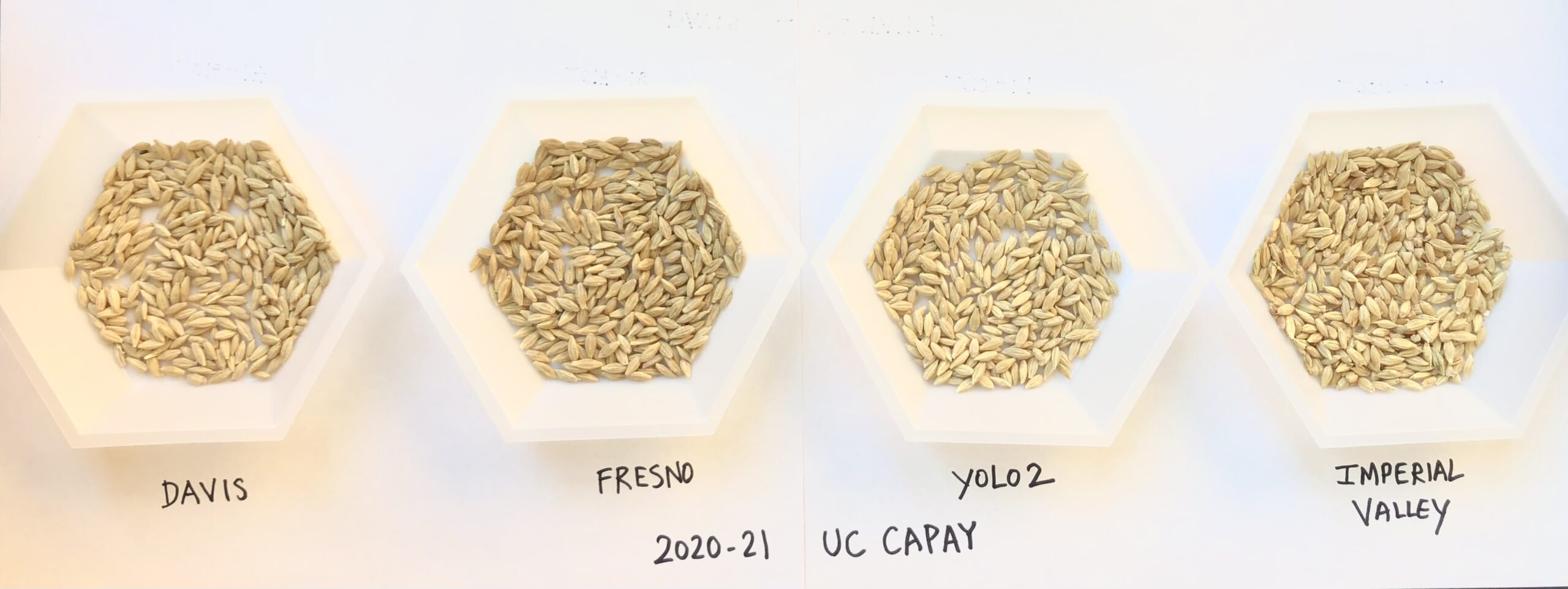By Maany Ramanan, PhD candidate at UC Davis & Founder of Thinai Inc.
Malting – it’s not just a science, it’s an art form. It is a complex and beautiful process that requires careful planning and execution. Imagine exploring the world of malting in the midst of a changing climate. That’s exactly what I’ve been doing as part of my doctoral research in Professor Fox’s and Professor Diepenbrock’s lab at University of California Davis.
With roots in an agricultural family and a seven-year tenure in the Aussie food industry, I witnessed alarming shifts in grain nutritional quality linked to environmental stresses. Motivated by this firsthand experience, my research seeks to unravel the ‘how’ and, more crucially, the ‘why’ behind these crop quality shifts.” The biggest question I had was whether quality is environment-driven, or perhaps the newer crop varieties behave differently in certain conditions (e.g., drought, heat)? I lucked out when I got into the UC Davis brewing program for my doctoral research, gaining access to an ample amount of malting barley from the sunny state of California which allowed me to delve into these questions.
Our multi-environment trial took 12 malting barley genotypes on a whirlwind tour, visiting eight different locations across California over three crop years. Something worth noting is that malting barley traits can be temperamental. Some of them could be more influenced by the environment, and some could be primarily linked to the genetics of the barley variety. We were interested in understanding more about this balance.

So, what’s the headline? Environment had a greater influence on yield and most grain quality traits. The standout exception was Thousand Kernel Weight (TKW) – like the maverick in the group – dancing to its own beat and driven more by genetics.
Protein content – the diva amongst quality traits – was mostly (>70 %) influenced by environment (location and season). For maltsters, this suggests that your choice of variety will offer somewhat limited relief from problematic growing conditions. Careful collaboration with your farmers on growing practices, along with routine measurement and tracking of protein content across different grain lots, will be increasingly important parts of your malting success. It might also be time to broaden your horizons and source your grains from different regions (like California) to stay ahead of the climate curve.
As a more advanced quality metric, we decided to throw starch gelatinization into the mix. Starch gelatinization is a measure to determine how quickly the starch within the malt can be converted to sugars. It is usually represented by three temperatures indicating the start, peak and end of gelatinization. We know from prior research that it therefore can be a great indicator of malting barley quality, and we also wanted to see if genetics or environment would take the lead. And the results? Well, they’re surprising! Starting and peak gelatinization temperatures still followed the genetic rhythm, but the ending gelatinization temperature was more variable due to the environment. This simply means that maltsters sourcing barley from dry conditions might need a bit of extra steeping time for optimum modification.

We’re not stopping here; there’s more to explore within the barley endosperm. We think that perhaps, these well-known quality traits might not be enough to truly understand environmental impact going forward. There might be more in-depth quality traits that can be better linked to malting performance. We’re diving deep into physical traits like barley texture and starch granule size, and even those intricate protein sub-classes (more than 1000 of them!) are on our radar. Think of it as a treasure hunt, and we’re uncovering gems of knowledge to share with growers, maltsters, and brewers. One overarching question that also remains is whether our findings will be consistent across other barley growing regions in North America.
Our ultimate mission? To arm the industry with robust quality traits to weather the changing climate, so they don’t end up malting past a ‘pint’ of no return! Stay tuned for more on our adventures in the world of malting. If you want to get involved in or support efforts like these at UC Davis, please don’t hesitate to reach out.
Cheers to a future filled with great malt and great beer, made possible by more climate-resilient grains!
Contact details:
Maany Ramanan, PhD candidate at UC Davis & Founder of Thinai Inc. mramanan@ucdavis.edu
References:
- Ramanan, M., T. Nelsen, M. Lundy, C. Diepenbrock, and G.P. Fox. 2023. Effects of genotype and environment on productivity and quality in Californian malting barley. Agron. J. doi: 10.1002/agj2.21433.
- Turner, H.M., L. Elmore, J. Walling, J. Lachowiec, D. Mangel, et al. 2019. Effect of steeping regime on barley malt quality and its impacts on breeding program selection. ASBCJ 77(4): 267–281. doi: 10.1080/03610470.2019.1629794.
- Bahmani, M., C.E. O’Lone, A. Juhász, M. Nye-Wood, H. Dunn, et al. 2021. Application of Mass Spectrometry-Based Proteomics to Barley Research. J. Agric. Food Chem. 69(31): 8591–8609. doi: 10.1021/acs.jafc.1c01871.



You must be logged in to post a comment.